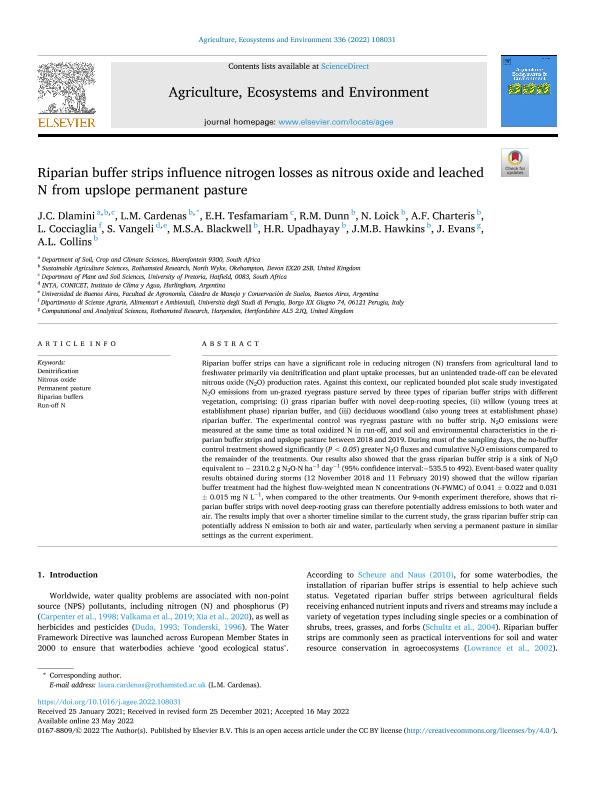Artículo
Riparian buffer strips influence nitrogen losses as nitrous oxide and leached N from upslope permanent pasture
Dlamini, J. C.; Cardenas, L. M.; Tesfamariam, E. H.; Dunn, R. M.; Loick, N.; Charteris, A.F.; Cocciaglia, L.; Vangeli, Sebastián ; Blackwell, M. S. A.; Upadhayay, H. R.; Hawkins, J. M. B.; Evans, J.; Collins, A. L.
; Blackwell, M. S. A.; Upadhayay, H. R.; Hawkins, J. M. B.; Evans, J.; Collins, A. L.
 ; Blackwell, M. S. A.; Upadhayay, H. R.; Hawkins, J. M. B.; Evans, J.; Collins, A. L.
; Blackwell, M. S. A.; Upadhayay, H. R.; Hawkins, J. M. B.; Evans, J.; Collins, A. L.
Fecha de publicación:
09/2022
Editorial:
Elsevier Science
Revista:
Agriculture, Ecosystems and Environment
ISSN:
0167-8809
Idioma:
Inglés
Tipo de recurso:
Artículo publicado
Clasificación temática:
Resumen
Riparian buffer strips can have a significant role in reducing nitrogen (N) transfers from agricultural land to freshwater primarily via denitrification and plant uptake processes, but an unintended trade-off can be elevated nitrous oxide (N2O) production rates. Against this context, our replicated bounded plot scale study investigated N2O emissions from un-grazed ryegrass pasture served by three types of riparian buffer strips with different vegetation, comprising: (i) grass riparian buffer with novel deep-rooting species, (ii) willow (young trees at establishment phase) riparian buffer, and (iii) deciduous woodland (also young trees at establishment phase) riparian buffer. The experimental control was ryegrass pasture with no buffer strip. N2O emissions were measured at the same time as total oxidized N in run-off, and soil and environmental characteristics in the riparian buffer strips and upslope pasture between 2018 and 2019. During most of the sampling days, the no-buffer control treatment showed significantly (P < 0.05) greater N2O fluxes and cumulative N2O emissions compared to the remainder of the treatments. Our results also showed that the grass riparian buffer strip is a sink of N2O equivalent to − 2310.2 g N2O-N ha−1 day−1 (95% confidence interval:−535.5 to 492). Event-based water quality results obtained during storms (12 November 2018 and 11 February 2019) showed that the willow riparian buffer treatment had the highest flow-weighted mean N concentrations (N-FWMC) of 0.041 ± 0.022 and 0.031 ± 0.015 mg N L−1, when compared to the other treatments. Our 9-month experiment therefore, shows that riparian buffer strips with novel deep-rooting grass can therefore potentially address emissions to both water and air. The results imply that over a shorter timeline similar to the current study, the grass riparian buffer strip can potentially address N emission to both air and water, particularly when serving a permanent pasture in similar settings as the current experiment.
Palabras clave:
DENITRIFICATION
,
NITROUS OXIDE
,
PERMANENT PASTURE
,
RIPARIAN BUFFERS
,
RUN-OFF N
Archivos asociados
Licencia
Identificadores
Colecciones
Articulos(SEDE CENTRAL)
Articulos de SEDE CENTRAL
Articulos de SEDE CENTRAL
Citación
Dlamini, J. C.; Cardenas, L. M.; Tesfamariam, E. H.; Dunn, R. M.; Loick, N.; et al.; Riparian buffer strips influence nitrogen losses as nitrous oxide and leached N from upslope permanent pasture; Elsevier Science; Agriculture, Ecosystems and Environment; 336; 9-2022; 1-14
Compartir
Altmétricas



